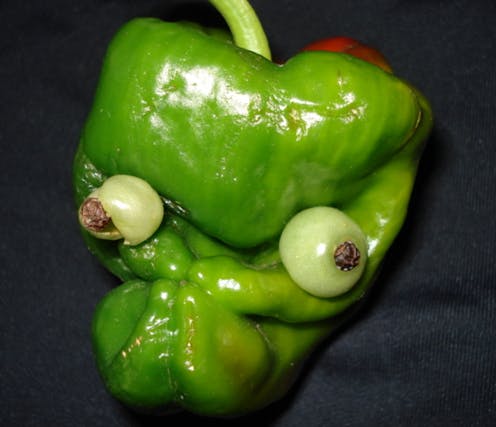How 'ugly' fruit and vegetables could tackle food waste and solve supermarket supply shortages
- Written by Behzad Hezarkhani, Reader in Operations Management, Brunel University London

The world is facing a significant food waste problem, with up to half of all fruit and vegetables[1] lost somewhere along the agricultural food chain. Globally, around 14% of food produced[2] is lost after harvesting but before it reaches shops and supermarkets.
Alongside food prices (66%), food waste is a concern for 60% of people that participated in a recent survey[3] published by the UK Food Standards Agency. Other research[4] suggests that as much as 25% of apples, 20% of onions and 13% of potatoes grown in the UK are destroyed because they don’t look right. This means that producers’ efforts to meet stringent specifications from buyers can lead to perfectly edible produce being discarded[5] before it even leaves the farm – simply because of how it looks.
Read more: Ugly veg: supermarkets aren't the biggest food wasters – you are[6]
Aside from the ongoing environmental implications of this food waste, UK shoppers currently face produce rationing in some supermarkets[7] due to shortages of items like tomatoes, cucumbers and raspberries[8]. Any solutions that increase locally grown produce on shop shelves could improve the availability of fresh food, particularly in urban areas.
When imperfect fruit and vegetables don’t make it to supermarket shelves, it’s can be due to cosmetic standards[9]. Supermarkets and consumers often prefer produce of a fairly standard size that’s free of blemishes, scars and other imperfections. This means fruit and vegetables that are misshapen, discoloured, or even too small or too large, are rejected before they make it to supermarket shelves.
In recent years there has been a growing trend of selling such “ugly” fruit and vegetables, both by major[10] supermarket[11] chains[12], as well as speciality[13] retailers[14] that sell boxes[15] of wonky produce[16]. And research has shown that 87% of people say they would eat wonky fruit and vegetables if they were available[17]. But other research indicates consumers can still be picky and difficult to predict. One study showed[18] consumers are likely to throw away an apple with a spot, but would eat a bent cucumber.
Getting ugly produce into baskets
So how can producers and retailers boost the amount of non-standard fruit and veg that not only reaches our shelves, but also our plates? Our recent research[20] suggests a separate channel for selling ugly produce would increase profits for growers, lower prices for consumers and boost overall demand for produce.
For growers, a dedicated channel – either independent or set up by a supermarket – to supply wonky fruit and veg creates a new line of business. For retailers, this provides an opportunity for further revenue over and above current sales of standard produce to shops. When selling both types of product to a single retailer, the ugly items might be undervalued compared with the standard-looking products. Our research also shows that selling the ugly produce through a dedicated channel is likely to increase total demand for fruit and vegetables, while also decreasing on-farm loss.
Having two parallel channels for selling produce (the main one and the dedicated “ugly” channel) would increase competition. This benefits shoppers by lowering prices for regular and ugly produce, versus selling both types of products alongside each other in one shop.
On the other hand, the growing market for ugly fruit and vegetables could be an economic threat to traditional retailers. It encourages new entrants into the market and could also limit the availability of “regular” produce because growers could become less stringent about ensuring produce meets traditional cosmetic standards.
But there is a way for traditional retailers to add ugly produce into their product offerings alongside other produce without affecting their profits. By building on existing consumer awareness of the environmental benefits of ugly food, they could also compete in this growing segment. This would benefit their bottom lines and help consumer acceptance of misshapen fruit and vegetables, possibly leading to less food waste and shortages like those UK shoppers are experiencing right now.
References
- ^ up to half of all fruit and vegetables (www.fao.org)
- ^ 14% of food produced (www.fao.org)
- ^ recent survey (www.food.gov.uk)
- ^ Other research (publications.parliament.uk)
- ^ perfectly edible produce being discarded (publications.parliament.uk)
- ^ Ugly veg: supermarkets aren't the biggest food wasters – you are (theconversation.com)
- ^ produce rationing in some supermarkets (www.theguardian.com)
- ^ shortages of items like tomatoes, cucumbers and raspberries (www.cnbc.com)
- ^ cosmetic standards (cases.open.ubc.ca)
- ^ major (my.morrisons.com)
- ^ supermarket (www.waitrose.com)
- ^ chains (www.tescoplc.com)
- ^ speciality (wonkyvegboxes.co.uk)
- ^ retailers (www.misfitsmarket.com)
- ^ boxes (www.oddbox.co.uk)
- ^ wonky produce (etepetete-bio.de)
- ^ eat wonky fruit and vegetables if they were available (www.thegrocer.co.uk)
- ^ showed (www.sciencedirect.com)
- ^ EQRoy/Shutterstock (www.shutterstock.com)
- ^ Our recent research (www.sciencedirect.com)
- ^ j.chizhe/Shutterstock (www.shutterstock.com)







